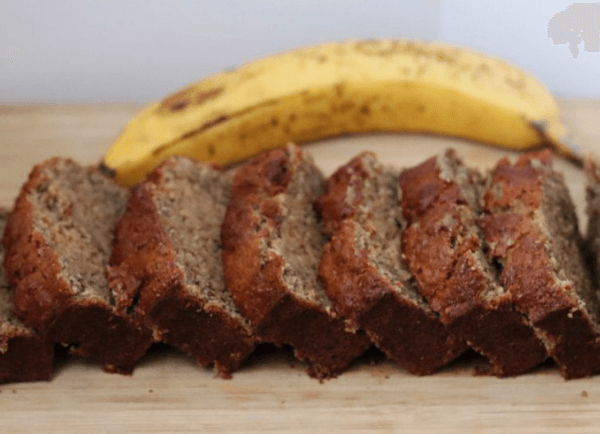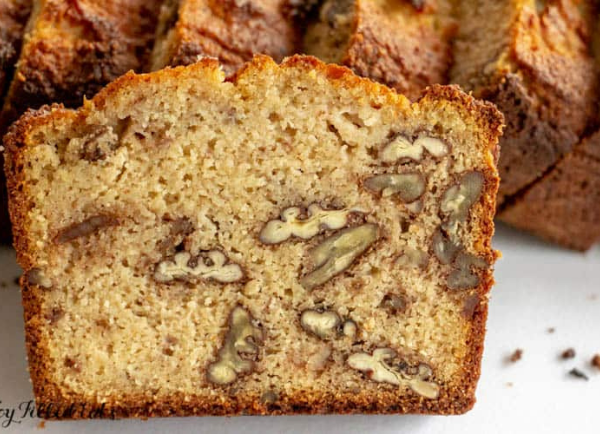Healthy Recipes for Banana Bread
What's "Healthy"? How Can I Make Banana Bread Healthy?
What is “healthy”? Have you ever had a friend say “I’m going to start eating more healthy!” only to find them eating popcorn instead of potato chips, or low-fat yogurt instead of regular?
Healthy can be so relative, so I’m going to try and create a definition for us and then give you some examples of my favorite treat turned healthy: banana bread!
Scroll down to find the best AIP, Paleo, and Keto.
When I talk about health with my clients I mean so many things:
- Proper nutrients
- Balance of the body systems (detox, neuroendocrine, and gastrointestinal health)
- Energized instead of fatigued
- Balanced hormones
- Strong and mobile muscles
- Feeling great!
There’s so many more ways I use the word healthy, but let’s get one thing straight...
Healthy does not mean buying processed food with “healthy” marketing.
In fact, you could argue that food isn’t even able to be “healthy.” People are healthy and food has varying amounts of nutrition supplied in it. So when it comes to recipes, I like to challenge my clients to look at the nutrients provided in the foods they eat.
You can be strategic in what you eat so you are consuming the highest quality nutrients possible. This means you’ll eat a variety of fresh, unprocessed foods. Mostly vegetables with meats/fish and some fruits. Often organic or grass-fed. Foods rich in vitamins and minerals that are as locally sourced as possible.
The farmers market isn’t just a fad…it’s probably your best source of nutrient-dense food unless you have your own farm/garden.
Different bodies need varying amounts of different nutrients. For example, one person might need less carbs than his neighbor.
This is bio-individuality, that portion size, nutrient combinations and quality will all affect a person in an individual way. For example, a 180lb woman athlete who is 5’10” will need a different amount of water, food, and nutrient combination than a 130lb woman who is 5’6” and is a busy mom with different genetics.
When I work with clients we do appropriate testing to learn what their body needs and then I use a several different nutrition plans to cater to those needs. A few of those nutrition plans include: AIP (Autoimmune Protocol), Paleo, Keto, and Shake the Sugar (a particular diet connected to one of my programs to help people detox from sugar).
Below are my favorite recipes for Banana Bread for each nutrition plan along with a short explanation of each plan!
AIP
AIP stands for Autoimmune Protocol. It is a nutrition plan that aims to reduce inflammation, pain, and other symptoms caused by autoimmune diseases. It’s characterized as being pretty restrictive by eliminating most sugars, all grains, all nuts, all dairy, and nightshades.
Remember that on a typical AIP meal plan, you would limit the amount of sugary food like maple syrup and bananas. Banana bread is really a kind of cake, so eat it as a fun treat! (not a main course)
AIP Banana Bread
Ingredients:
1 cup mashed ripe banana (about 2 large bananas)
1 cup + ⅓ cup tigernut flour
¼ cup + 1 Tbsp arrowroot (could substitute tapioca starch)
¼ cup maple syrup
¼ cup full-fat coconut milk
1 tablespoon apple cider vinegar (or lemon juice)
1 teaspoon vanilla
1 teaspoon baking soda
2 teaspoons cinnamon
1 teaspoon nutmeg

Instructions:
- Preheat oven to 360° F (180° C)
- Peel the bananas, put them in a large bowl and mash them with a fork. Add the maple syrup, coconut milk, apple cider vinagar and vanilla and mix until well combined. You can also use a blender to make sure you get a very homogenous mix.
- In a separate bowl, combine all the dry ingredients (flour, arrow root, baking soda and spices). Stir to ensure there are no clumps.
- Add the wet ingredients to the dry ingredients and mix with a spoon until well combined.
- Line or lightly oil a rectangular 4 x 8 inches (10 x 20 cm) baking tin and transfer the batter into the tin.
- Bake for about 35 minutes. To make sure that it is cooked, insert a thin bladed knife into the center of the banana bread, the knife should come out clean. Wait for the banana bread to cool down before removing from the tin.
Paleo
Paleo is short for paleolithic and is founded on eating similar foods to the paleolithic era. One of the most popular branded diets that falls under paleo is Whole30. Paleo is characterized by limiting all dairy, all grains, and all processed foods. It does allow nuts and seeds, nightshades, and more fruits, unlike AIP.
Just like AIP, the paleo nutrition plan puts sugary foods like coconut sugar into a “limit” category, so enjoy this bread as a special treat instead of a full meal.
Paleo Banana Bread
Ingredients:
3 overripe medium bananas
3 large eggs
½ cup coconut sugar
½ cup full-fat coconut milk
2 tablespoon coconut oil melted and cooled
1 ½ teaspoon vanilla extract
1 ½ cups cassava flour (strongly recommend Otto’s)
1 teaspoon baking soda
pinch sea salt
2 teaspoon cinnamon

Instructions:
- Preheat your oven to 350 degrees and prepare a standard loaf pan by lining with parchment paper.
- In a large bowl, mash the bananas well, and, either by hand or with an electric mixer, whisk together the mashed bananas and eggs. Add the coconut sugar, coconut milk, coconut oil, and vanilla extract and mix until smooth and incorporated.
- In a smaller bowl combine the cassava flour, baking soda, salt, and cinnamon. Slowly stir the dry mixture into the wet to fully combine and don't overmix. Batter will be thick.
- Slowly pour all of the batter into the parchment-lined loaf pan. Smooth out the top.
- Bake in the middle of the preheated oven for 1 hour - 1 hour 15 minutes, or until a toothpick comes out mainly clean (crumbs are okay.)
- Remove from oven and let sit for 5 minutes, then transfer the entire loaf to a wire rack to cool completely for at least an hour before serving.
Keto
Keto is short for ketosis which is a process where the body starts burning fat instead of carbohydrates. When this happens the body creates ketones which is used for fuel. It was made popular in the 1990’s but popularity spiked in the last couple years. The nutrition plan increases fat intake and decreases carbohydrate intake in effort to help regulate body systems, particularly the neuroendricrine system. Keto is NOT for everyone, so don’t just follow the diet fads without consulting a qualified practitioner.
This is a bit of a trick! Bananas really should be eliminated from the diet if one is strictly following a keto diet, but you’ll find PLENTY of “keto” banana bread recipes out there. Why? Everyone’s version of keto is different. And just like other fad diets, Keto has become a brand for “low-fat” just as much as a description. I’ve provided a recipe that fits the version of Keto I use with clients.
Keto Banana Bread
Ingredients:
2 teaspoons banana extract (best option is to make your own! Otherwise, use high quality)
3 large eggs
2 cups almond flour
1/4 cup coconut oil
1 tsp baking soda
1 tsp pure powdered stevia
1/2 cup walnuts (optional)

Instructions:
- Preheat oven to 350F.
- In a food processor or a bowl, add eggs and beat. Add banana extract. Add coconut oil. Mix.
- In a separate bowl mix together the almond flour, baking soda, and stevia.
- Combine the two mixtures together until well blended. Toss in the walnuts if using.
- Line a standard size loaf pan with parchment paper. Pour batter in spreading it out evenly.
- Bake for 45-60 minutes. Test the bread to ensure it’s done.
Shake the Sugar
Shake the Sugar is a particular diet created for my sugar detox program. When you are detoxing from sugar, you should eliminate ALL forms of sugar. So this is sort of a trick nutrition plan to have a banana bread recipe. Why? Because bananas have sugar in them which means for the time you are on this diet, you should stay clear of bananas and therefore banana bread.
Try out one of these recipes and let me know how you like it. Remember, banana bread is a fun treat! Treat it that way (pun intended) and you will have much more balance in your life and therefore be supporting your body towards health!
Don't Miss Out On More!

Heidi Toy FNTP
I help people all over the world heal by identifying and treating the root cause of their body imbalances. Through diet and nutrition, I guide them towards wholeness and balanced lives.
Heidi Toy Functional Medicine Blog














































































































